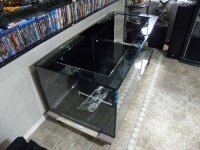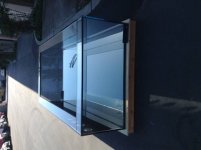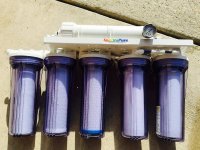http://www.thefilterguys.biz/chloramine_filters.htm
If you do have Chloramine here is the place to start. They offer test kits. Mid way down on this page they have carbon designed for Chloramine.
If you do have Chloramine here is the place to start. They offer test kits. Mid way down on this page they have carbon designed for Chloramine.
He doesn't need to make di, I get what your saying about your resin, but the di is because of your reef tanks. No one in the hydro industry cares much about diSome just plain wrong info in here. It boggles the mind that people offer advice on topics they don't know anything about. Carbon will barely even touch Chloramines, and you absolutely do not need a water softener to elongate your resin or maintain a TDS of 000 on the output.
OP: noticed you said you have your unit plumbed to a float valve. Are you making small batches at a time in a res, flushing your unit and then taking it off line, or is it continually cycling via the float valve/ pressure from your tap? If it's the latter, then there's your problem.
The tds coming out of the membrane at short intervals causes tds that is extremely high. As the bobber float only calls for small amounts of water, it causes what is called TDS creep. This exhausts the DI resin up to five times faster.
My municipal tap contains like 3X the average in Chloramine content(Rant: Chloramine is highly overhyped as being detrimental to plant health, and I personally feed straight out of the tap in dirt. In my DWC system and aquariums however, I'm all RODI)
My method:And trust me: I've been put through the ringer on dialing in the most cost efficient methods to overcome my Tap's impossibly high Chloramines( Not because I believe they effect the root system, but only because Chloramines rapidly exhaust DI resin, which is expensive)
I run a 4 stage Maxcap 180GPD RODI Spectrapure unit, I make 100 gallons at a time, flush, then take the unit offline with the turn of a valve. For fillup/ ATO, which feed both my aquarium sumps and topoff Res, I employ a Spectrapure UPLC-II ATO which also uses a digital air sensor that can be adjusted between 1/10" and 4" with the touch of a button. It also comes with a back up high level float switch and the same three roller peristaltic pump as their Liter Meter III. It's bulletproof. The pump can also be adjusted in 10% increments as another level of failsafe, so you can adjust the fill rate.
My ATO res is like 40 feet away in my basement. The ULPC has no issue pulling the water that distance and can actually pump up to about 45 psi vertical if needed.
That's the ultimate fix dude. Albeit, expensive upfront. My shit sparkles out of that water line though, I rarely have to buy DI, and I run a ton of volume through my lines. Good luck

 "near every R/O is setup on a float valve, hence automating the process, not making it complicated"
"near every R/O is setup on a float valve, hence automating the process, not making it complicated" 



